Peugeot 407 2006 Owner Manual
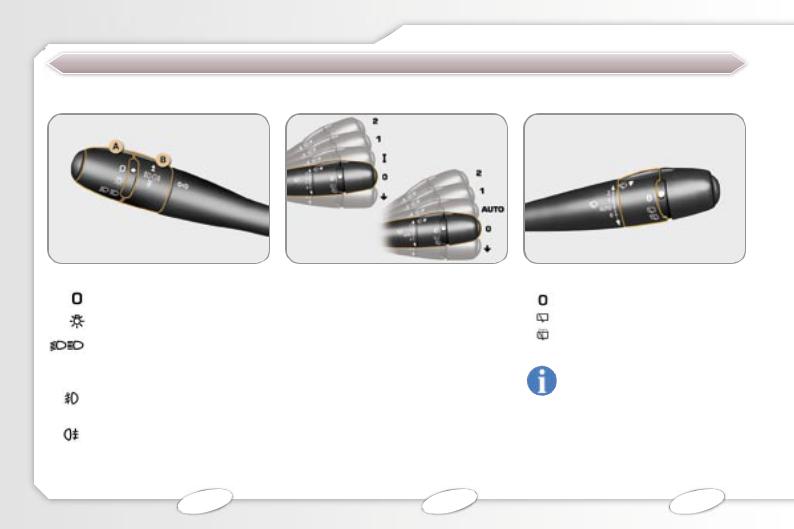
FAMILIARISATION
SEEING CLEARLY
Lights |
Wipers |
Ring A
Lights off.
Side lights.
Dipped / Main beam headlamps.
Ring B
Front fog lamps (one press).
Rear fog lamps (two presses).
10 |
77 |
|
Windscreen wipers with intermittent |
Rear wiper (407SW) |
||||
wipe |
Park. |
|
|
||
2 |
Fast wipe. |
|
|
||
Intermittent wipe. |
|||||
1 |
Normal wipe. |
||||
|
|
|
|||
I |
Intermittent wipe. |
Wash-wipe. |
|||
0 |
Park. |
|
|
|
|
|
Single wipe. |
Also... |
|
|
|
|
|
|
|
||
Windscreen wipers with automatic |
When |
the |
windscreen wipers |
||
control |
is |
activated and you |
|||
wipe |
|||||
engage reverse gear, the rear |
|||||
2 |
Fast wipe. |
||||
wiper |
operates in intermittent |
||||
1 |
Normal wipe. |
mode. |
|
|
|
AUTO Automatic wipe.
0Park.
Single wipe.
80 |
81 |
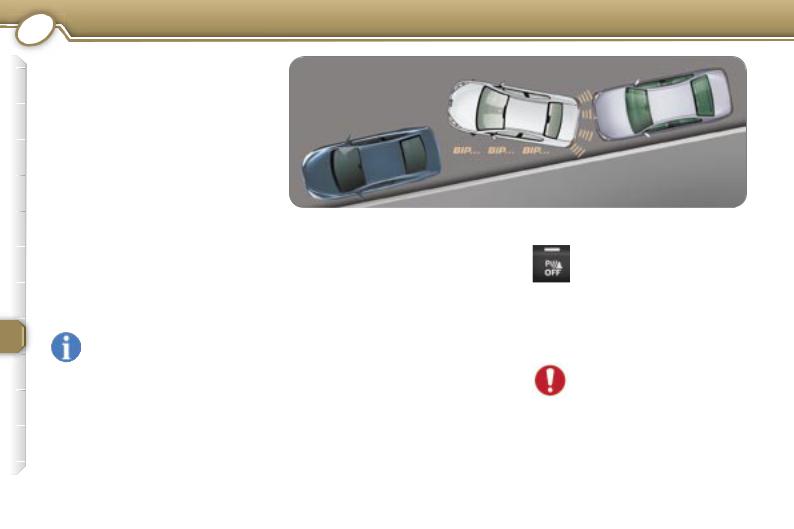
8DRIVING
AUDIBLE REAR PARKING ASSISTANCE
This system consists of four proximity sensors, located in the rear bumper.
This detects any obstacle (person, cyclist, vehicle, tree, gate, etc.) behind the vehicle. Nevertheless, it cannot detect obstacles located just below the bumper.
Warning: an object, such as a stake, a roadworks cone or any other similar object detected at the beginning of the manoeuvre may no longer be detected during the manoeuvre.
To make manoeuvres in reverse gear easier, adjust your mirrors in accordance with the "Automatic tilting of the mirrors in reverse gear" function.
Maintenance: ensure that the sensors are not covered with mud, frost or snow.
Activation
The system is activated as soon as reverse gear is engaged; an audible bleep shows that it is active.
The proximity information is given by an audible signal, which becomes more rapid as the vehicle approaches the obstacle.
Your vehicle’s rear speakers emit an audible signal:
-on the right if an obstacle is detected on the right,
-on the left if an obstacle is detected on the left,
-on the right and left if an obstacle is detected in the centre.
When the |
distance between the |
rear of the |
vehicle and the obstacle |
is less than approximately twenty-
five centimetres, the audible signal becomes continuous.
Switching the system off
Change to neutral, the system is again inactive.
Deactivation
Press the switch on the centre console.
The indicator light on the switch comes on and the system becomes completely inactive.
If there is an operating fault, on changing to reverse gear a warning light on the instrument panel, an audible signal
and a message on the multifunction display indicate that there is a system malfunction.
Contact a PEUGEOT dealer.
104

TYRE UNDER-INFLATION DETECTION
Sensors check the tyre pressure during driving and trigger a warning in the event of malfunction.
Flat tyre
Instrument panel warning light.
This is accompanied by the message on the multifunction display locating the wheel concerned.
Instrument panel display warning light.
This is accompanied by the audible signal and the message on the multifunction display locating the wheel concerned.
If this warning light comes on, have the tyre pressure checked as soon as possible.
Puncture
This warning light, accompanied by the audible signal and the message on the multi-function display locating the wheel concerned, is followed by illumination of the "STOP" warning light.
Stop immediately, avoiding any sudden movement of the steering wheel and the brakes.
Change the damaged wheel (punctured or very deflated tyre), and have the tyre pressure checked as soon as possible.
Sensor(s) not detected or faulty
Instrument panel warning light.
Thisisaccompanied by the mesage on the multifunction display which indicates that underinflation detection is absent from one (or several) wheel(s) or that there is a fault in the system.
Instrument panel display warning light.
This is accompanied by the audible signal and the message on the multifunction display which indicates that under-inflation detection is absent from one (or several) wheel(s) or that there is a fault in the system.
Contact a PEUGEOT dealer to replace the faulty sensor(s).
Note: this message is also displayed when one of the wheels is away from the vehicle (being repaired) or when one or more wheels without a
sensor are fitted.
DRIVING 8
All repairs and changing of tyres on a wheel fitted with this system must be carried out by a PEUGEOT dealer.
If, when changing a tyre, you install a wheel which is not detected by your vehicle, you must have the system reinitialised by a PEUGEOT dealer.
The tyre under-inflation detection system is an aid to driving which does not replace the need for the driver to be vigilant or to drive responsibly.
This system does not eliminate the need to have the tyre pressure checked regularly (see manufacturer’s label on the door pillar) to ensure that the optimum dynamic performance of the vehicle is maintained and prevent prematurewearofthetyres,particularly in arduous driving conditions (heavy load, high speed).
The tyre pressures must be checked cold, at least once a month. Remember to check the pressure of the spare wheel.
The tyre under-inflation detection system may experience temporary interference due to radioelectric emissions on a frequency close to that used by the system.
105
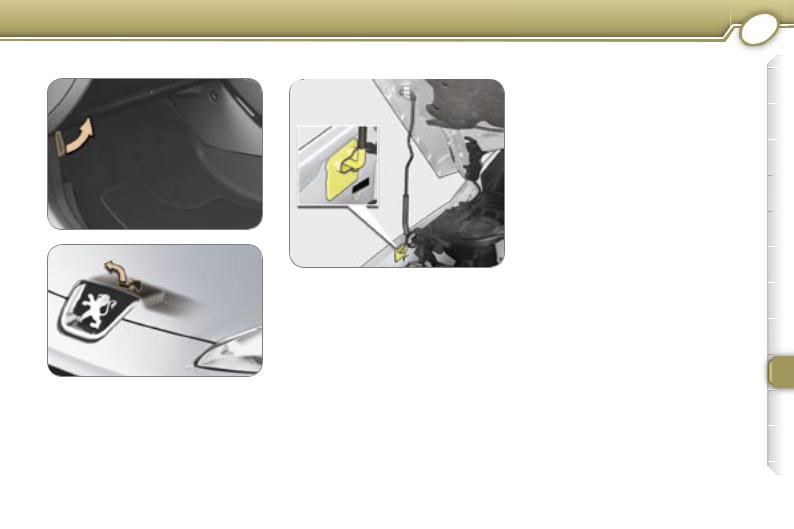
CHECKS 9
OPENING THE BONNET |
Bonnet strut |
From inside: pull the handle on the left-hand side under the fascia towards you.
From outside: move the catch to the left and up then raise the bonnet.
Secure the strut in its housing to hold the bonnet open.
Before closing the bonnet, replace the strut in its clip.
To close
Lower the bonnet and release it at the end of its travel. Check that the bonnet is properly locked.
107

9CHECKS
1.8 LITRE and 2 LITRE 16V
PETROL ENGINES
Important: if you have to remove or refit the engine style cover, handle it with care
clips. to avoid damaging the fixing Check the levels!
1 - Power steering reservoir.
2 - Engine coolant reservoir (expansion bottle).
3 - Engine oil filler cap.
4 - Brake fluid reservoir.
5 - Air filter.
6 - Dipstick.
7 - Windscreen and headlamp* wash filler cap.
108 |
* According to country. |
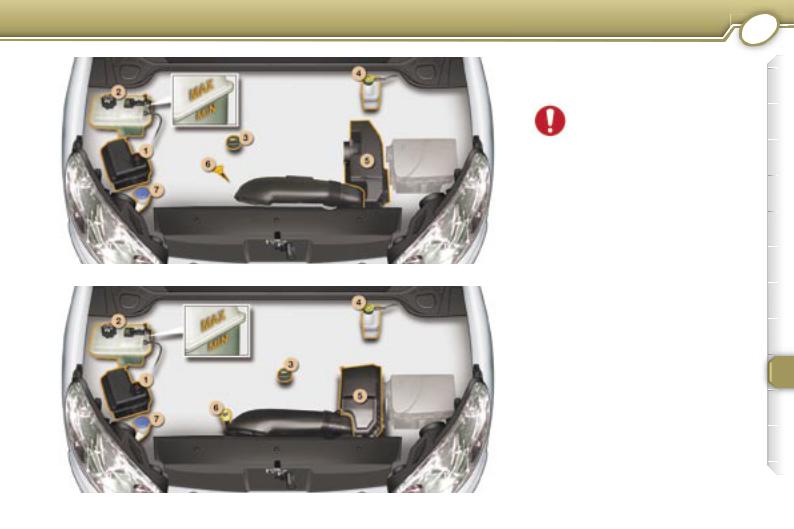
CHECKS 9
2.2 LITRE 16V and
3 LITRE V6 24V PETROL ENGINES
Important: if you have to remove or refit the engine style cover, handle it with care
clips. to avoid damaging the fixing Check the levels!
1 - Power steering reservoir.
2 - Engine coolant reservoir (expansion bottle).
3 - Engine oil filler cap.
4 - Brake fluid reservoir.
5 - Air filter.
6 - Dipstick.
7 - Windscreen and headlamp* wash filler cap.
* According to country. |
109 |
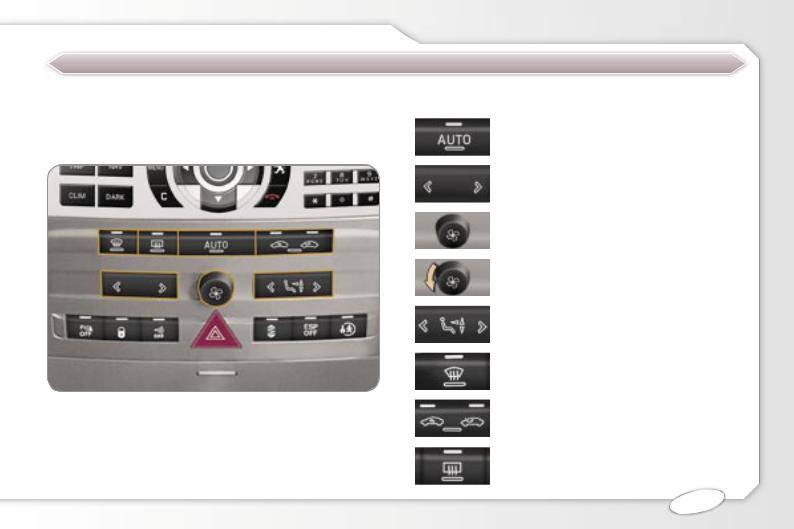
FAMILIARISATION
VENTILATION
Automatic air conditioning (mono zone)
Automatic programme (comfort).
Temperature adjustment.
Air flow adjustment.
Air conditioning off.
Air distribution adjustment.
Front visibility control.
Intake of exterior air.
Recirculation of interior air.
Rear screen demisting.
40 |
11 |
|
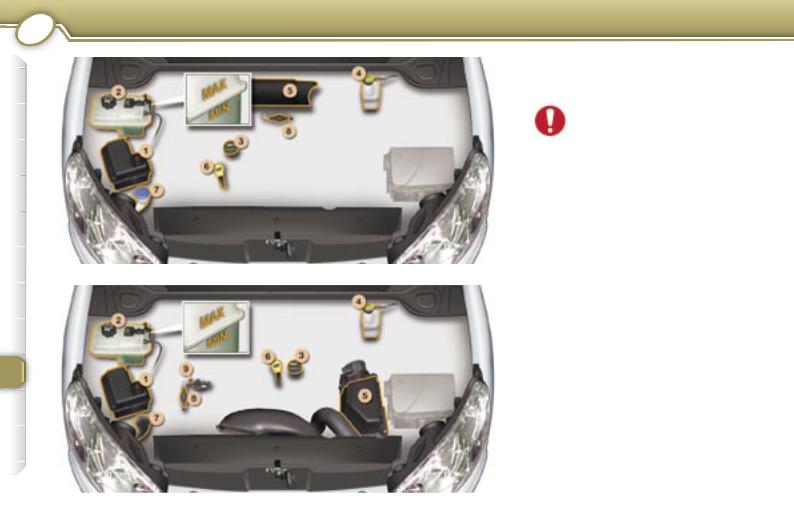
9CHECKS
1.6 LITRE HDI 16V and
2 LITRE HDI 16V
DIESEL ENGINES
Important: if you have to remove / refit the engine style cover, handle it with care to
clips. avoid damaging the fixing Check the levels!
1 - Power steering reservoir.
2 - Engine coolant reservoir (expansion bottle).
3 - Engine oil filler cap.
4 - Brake fluid reservoir.
5 - Air filter.
6 - Dipstick.
7 - Windscreen and headlamp wash* filler cap.
8 - Priming pump.
9 - Degas screw.
110 |
* According to country. |
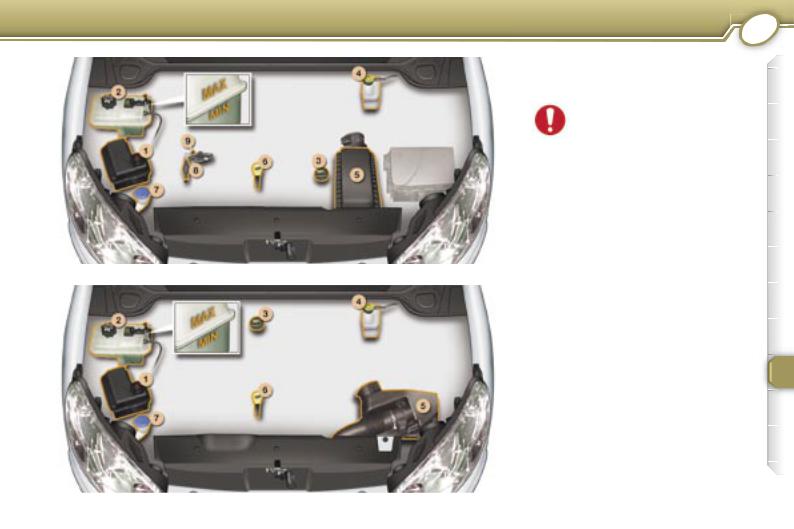
CHECKS 9
2.2 LITRE HDI 16V and
2.7 LITRE HDI 24V DIESEL ENGINES
Important: if you have to remove / refit the engine style cover, handle it with care to
clips. avoid damaging the fixing Check the levels!
1 - Power steering reservoir.
2 - Engine coolant reservoir (expansion bottle).
3 - Engine oil filler cap.
4 - Brake fluid reservoir.
5 - Air filter.
6 - Dipstick.
7 - Windscreen and headlamp wash* filler cap.
8 - Priming pump.
9 - Degas screw.
* According to country. |
111 |
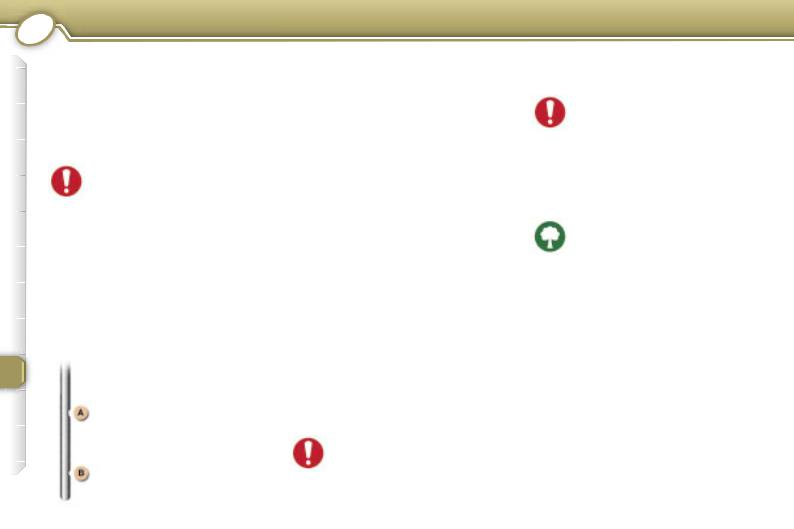
9CHECKS
CHECKING THE LEVELS
These are normal maintenance operations which keep your vehicle in good working order. Consult the instructions in the PEUGEOT Network, on the Infotec site or in the servicing booklet enclosed with this handbook.
Important: if you have to remove/refit the engine style cover, handle it with care to
clips. avoid damaging the fixing
Oil level
Check the level regularly and top up between changes.
Check the level with the vehicle level, the engine having been off for more than 15 minutes, using the dipstick.
Dipstick
There are two marks on the dipstick:
A = maximum
Never fill past this mark.
B = minimum
To maintain the reliability of engines and emission control systems, the use of additives in engine oil is prohibited.
112
Oil change
It is imperative that this is carried out at the intervals specified and the viscosity of the oil chosen must meet the requirements laid down in the manufacturer’s servicing schedule. Consult the instructions in the PEUGEOT Network or on the Infotec site.
Note: avoid used oil coming into prolonged contact with the skin. Empty the used oil into the containers provided for this purpose in the PEUGEOT Network.
Oil filter
Replace the cartridge regularly in accordance with the recommendations of the servicing schedule.
Brake fluid change
Use the fluid recommended by the manufacturer, which fulfils DOT4 Standards.
It is imperative that the brake fluid is changed at the intervals specified in accordance with the manufacturer’s servicing schedule.
Note: avoid all contact with the skin, the brake fluid is harmful to health and very corrosive.
Cooling system
Use the fluid recommended by the manufacturer.
When the engine is warm, the temperature of the coolant is controlled by the engine fan. As this fan can operate with the ignition key removed and because the cooling
system is pressurised, wait for at least one hour after the engine has stopped before carrying out any work.
Slacken the cap by two turns to release the pressure to prevent any risk of scalding. When the pressure has
dropped, remove the cap and top up the level.
Note: the coolant does not need to be changed.
Used oil
Do not dispose of used oil, brake fluid or coolant into drains or onto the ground.
Power steering reservoir
Use the fluid recommended by the manufacturer.
Open the reservoir, with the engine at ambient temperature. The level should always be above the MIN. mark and close to the MAX. mark.
Windscreen and headlamp wash level
For best quality cleaning and for your safety, to see and be seen, we would advise that you use products of the Universal range recommended by PEUGEOT, of particular benefit if your 407 is fitted with Xenon bulbs.
To prevent damage to the electrical units, avoid washing the engine.
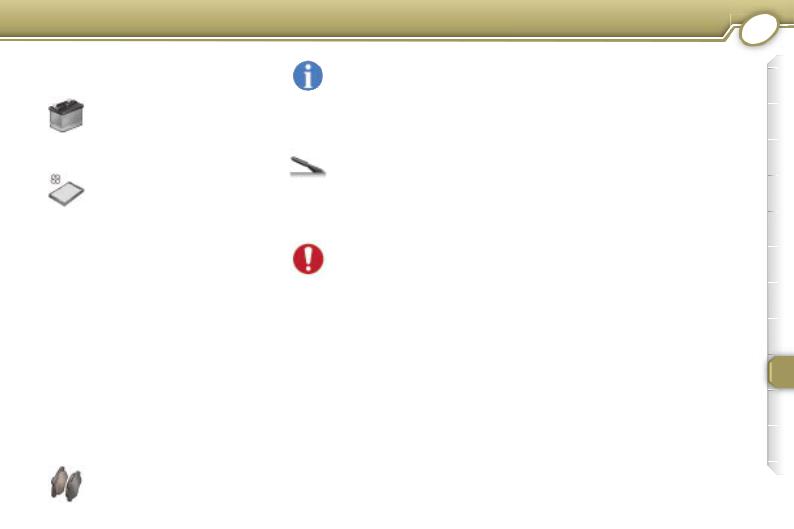
CHECKS
Battery
At the start of winter, have your battery checked by a PEUGEOT dealer.
Air filter and passenger compartment filter
Have the filter elements replaced regularly. If you drive in dusty conditions, change them twice as often.
Particle emission filter (Diesel)
Itisimperativethattheparticleemission filter is maintained in accordance with the manufacturer’s servicing schedule, by a PEUGEOT dealer.
Note: following prolonged operation of the vehicle at very low speed or at idle, you may, in exceptional circumstances, notice emissions of water vapour at the exhaust on acceleration. This does not have any effect on the performance of the vehicle or the environment.
On vehicles which are fitted with a particle emission filter, the fan assembly may operate after the vehicle has stopped, even when the engine is cold.
Brake pads
Brake pad wear depends on the style of driving, in particular for vehicles which are used in town, over short distances.
It may be necessary to check the thickness of the pads, even between services.
Handbrake
Where the handbrake travel is too great or there is a reduction in the performance of the system, the handbrake
should be adjusted.
Have the system checked by a PEUGEOT dealer.
To ensure the best performance from components as important as the power steering and the braking system,
the manufacturer selects and offers specific products, only use products recommended by PEUGEOT.
FUEL SUPPLY CUT-OFF (PETROL)*
As a safety precaution, in certain circumstances, a mechanism prevents fuel from reaching the engine.
To re-establish the fuel supply :
press the red button on the angle of the front right-hand suspension assembly, under the bonnet.
CHECKS 9
RUNNING OUT OF FUEL (DIESEL)
If you should run out of fuel, it is necessary to re-prime the circuit.
The repriming pump and the degas screw are located under the bonnet (see corresponding illustration in the technical data section):
1.6 litre 16V HDI engine
- fill the fuel tank with at least five litres of diesel,
- squeeze and release the manual repriming pump, until fuel appears in the transparent pipe,
- operate the starter until the engine starts.
2 litre 16V HDI engine
- fill the fuel tank with at least five litres of diesel,
-unscrew the degas screw,
-squeeze and release the manual repriming pump until diesel is seen escaping via the degas screw,
- retighten the degas screw,
- operate the starter until the engine starts.
* According to version. |
113 |
|
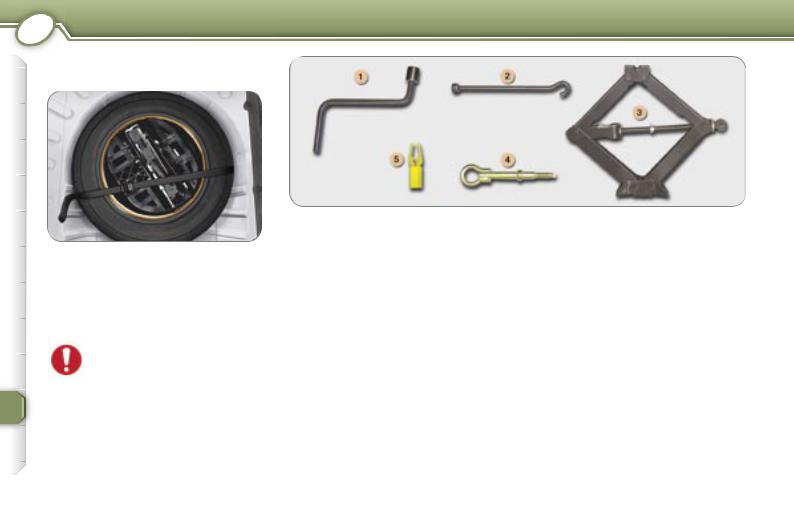
10 PRACTICAL INFORMATION
CHANGING A WHEEL
Park the vehicle on level, stable and non-slippery ground.
Apply the handbrake, switch off the ignition and engage first or reverse gear (position P for the automatic gearbox).
Never go underneath a vehicle which is supported only by a jack.
Access to the spare wheel and the jack in the boot
Lift the floor using the lifting handle. Secure the handle behind the boot seal.
Tools available
The following tools are located in the holder in the centre of the spare wheel:
1 - Wheelbrace.
2 - Wheelbrace extension.
3 - Jack.
4 - Removable towing eye.
5 - Alloy wheel trim cover tool (yellow tool).
Removal
For vehicles with steel wheels, detach the trim using extension 2 pulling at the valve passage hole.
For vehicles with alloy wheels, remove the trim covers using tool 5.
Loosen the wheel bolts.
Take the jack from the tool kit.
Place the jack 3 in one of the four locations underneath the vehicle (the nearest one to the wheel to be changed).
Extend the jack using wheelbrace 1 and the extension 2.
Unscrew the bolts and remove the wheel.
114
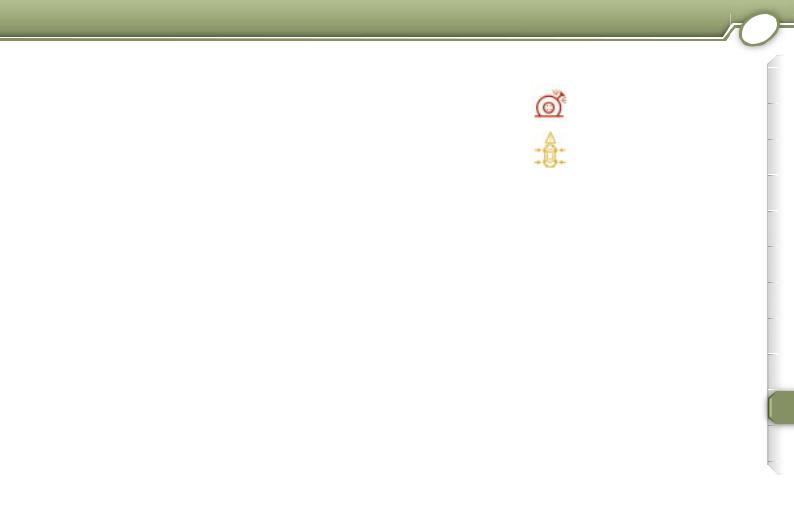
Fitting a wheel
Position the wheel.
Tighten the bolts by hand.
Partly tighten the bolts using the wheelbrace.
Fold the jack and remove it.
Fully tighten the bolts using the wheelbrace.
For vehicles with steel wheels, refit the wheel trim starting by placing its notch facing the valve and press with the palm of the hand.
For vehicles with alloy wheels, refit the trim covers.
Put the tool holder back in position. This helps to keep the boot floor in its correct position, to prevent any deformation of the floor when loaded.
Tighten the spare wheel securing strap to prevent noise and for your safety in the event of impact.
PRACTICAL INFORMATION 10
Reminder: for your safety, always change a wheel:
-on level, stable, non-slippery ground,
-with the handbrake applied,
-with first or reverse gear engaged (position P for the automatic gearbox),
-never go underneath a vehicle which is supported only by a jack.
After changing the wheel:
-have the tightening of the bolts and the tyre pressure of the spare wheel checked as soon as possible.
-have the punctured wheel repaired and refit it to the vehicle as soon as possible.
-have the spare wheel checked and replace it in its boot recess.
Recommendations when using the temporary spare wheel*
Your vehicle may be equipped with a spare wheel with a different rim to that of the standard wheel.
After use, replace it as soon as possible.
Follow the recommendations below to avoid any alteration in vehicle handling:
-do not drive above 50 mph (80 km/h),
-do not fit a wheel trim,
-drive carefully,
-check the inflation pressure indicated on the label.
Information on the instrument panel:
Punctured tyre warning light
Tyre under-inflation detection system warning light
These original wheels are fitted with a pressure sensor (see paragraph "Tyre under-inflation detection"). The alarm which detects the removal or absence of a wheel fitted with the indicator sensor signals the anomaly. Have the wheel repaired and checked by a PEUGEOT dealer.
* According to version and country. 115
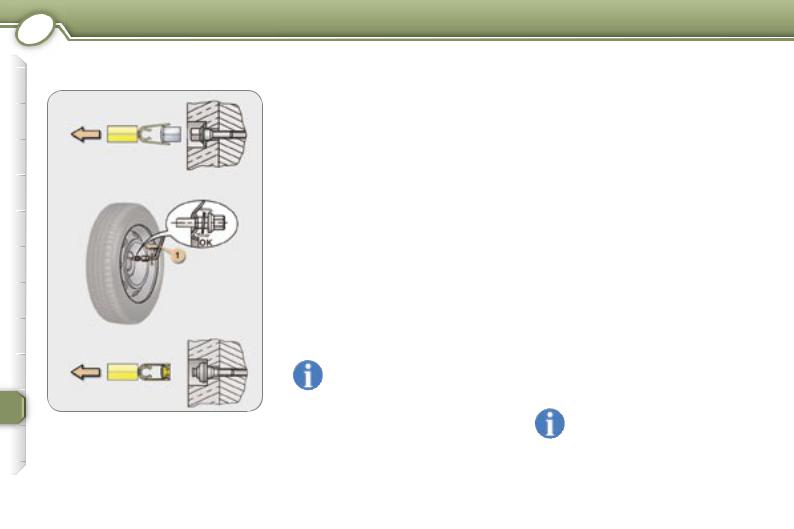
10 PRACTICAL INFORMATION
Special features of alloy wheels
Bolt covers
Alloy wheel bolts are covered by chrome trims.
Use the yellow tool to remove the trims before slackening the bolts.
Fitting the spare wheel
If your vehicle is fitted with a steel spare wheel, when fitting it, it is normal when tightening the bolts to notice that the washers do not come into contact with the rim. The spare wheel is secured by the cone shape of each bolt.
Fitting snow tyres
If you fit snow tyres mounted on steel wheels onto your vehicle, it is essential to use special bolts available from your PEUGEOT dealer.
Anti-theft bolts
Your wheels are fitted with anti-theft bolts (one per wheel), placed under chrome trims which must be removed using the yellow tool, before the bolts are unscrewed using the anti-theft socket and the wheel brace 1.
Note: this anti-theft socket was given to you on delivery of your vehicle with the duplicate keys and the confidential card.
Make a careful note of the code number engraved on the head of the anti-theft socket. This will enable you to obtain a duplicate anti-theft socket from a PEUGEOT dealer. You are advised to do the same for the duplicate keys and not to leave the confidential card in the vehicle.
116
PARTIAL REMOVABLE CLOSER*
The partial removable closer is a cover which is clipped onto the air intake grille to prevent the accumulation of snow due to direct splashes.
Once it has been fitted on your vehicle, it is imperative that it is removed when the ambient temperature conditions rise above 10 °C again.
Contact a PEUGEOT dealer.
Tyres of size 215/55 R17 cannot be fitted with standard snow chains, contact a PEUGEOT dealer.
* According to country.
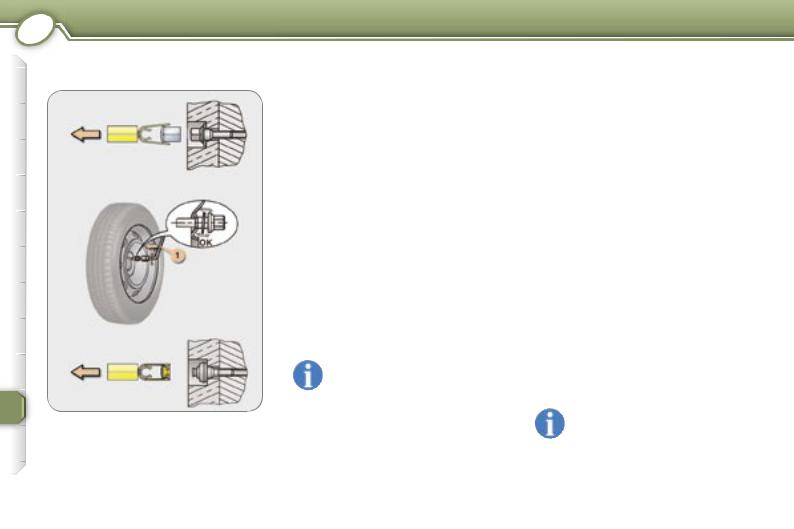
10 PRACTICAL INFORMATION
Special features of alloy wheels
Bolt covers
Alloy wheel bolts are covered by chrome trims.
Use the yellow tool to remove the trims before slackening the bolts.
Fitting the spare wheel
If your vehicle is fitted with a steel spare wheel, when fitting it, it is normal when tightening the bolts to notice that the washers do not come into contact with the rim. The spare wheel is secured by the cone shape of each bolt.
Fitting snow tyres
If you fit snow tyres mounted on steel wheels onto your vehicle, it is essential to use special bolts available from your PEUGEOT dealer.
Anti-theft bolts
Your wheels are fitted with anti-theft bolts (one per wheel), placed under chrome trims which must be removed using the yellow tool, before the bolts are unscrewed using the anti-theft socket and the wheel brace 1.
Note: this anti-theft socket was given to you on delivery of your vehicle with the duplicate keys and the confidential card.
Make a careful note of the code number engraved on the head of the anti-theft socket. This will enable you to obtain a duplicate anti-theft socket from a PEUGEOT dealer. You are advised to do the same for the duplicate keys and not to leave the confidential card in the vehicle.
116
PARTIAL REMOVABLE CLOSER*
The partial removable closer is a cover which is clipped onto the air intake grille to prevent the accumulation of snow due to direct splashes.
Once it has been fitted on your vehicle, it is imperative that it is removed when the ambient temperature conditions rise above 10 °C again.
Contact a PEUGEOT dealer.
Tyres of size 215/55 R17 cannot be fitted with standard snow chains, contact a PEUGEOT dealer.
* According to country.

CHANGING A FRONT BULB
Handle the bulbs with a dry cloth.
Front lights
In the engine compartment, remove the cover secured by one or two butterfly screws, a plastic retainer clip and two quarter turn screws.
1 - Dipped beam headlamps:
H1-55 W or D2S-35 W xenon bulb.
WARNING: RISK OF
ELECTROCUTION
Xenon bulbs must be replaced by a PEUGEOT dealer.
PRACTICAL INFORMATION 10
2 - Main beam headlamps:
H7-55 W.
Remove the protective cover corresponding to the faulty bulb.
Disconnect the connector.
Press the end of the securing clips to free the bulb. Change the bulb.
When fitting the new bulb, ensure that the direction notches are positioned correctly and the securing clips are fixed properly.
Reconnect the connector.
Refit the protective cover.
3 - Side lights: W 5 W.
Remove the protective cover, disconnect the connector and then remove the bulb and change it.
Put the connector back in place.
Reconnect the connector.
Refit the protective cover.
4 - Direction indicators:
PY 21 W (amber).
Turn the bulb holder a quarter turn and remove it.
Change the bulb.
Amber coloured bulbs (direction indicators and side repeaters) must be replaced with bulbs of identical specification and colour.
5 - Front fog lamps: H11 - 55 W.
Turn the wheels to full lock.
Access to the bulb is via the flap in the front mud flap.
Contact a PEUGEOT dealer.
The headlamps are fitted with polycarbonate glass with a protective coating. Do not clean them with a dry or abrasive cloth, nor with a detergent or solvent product.
Ensure that the liquid used to fill the wash-wipe and headlamp wash reservoir is of good quality.
In certain climatic conditions (low temperature, humidity), condensation on the inside surface of the headlamp glass is normal; it disappears a few minutes
after the lights are switched on.
117
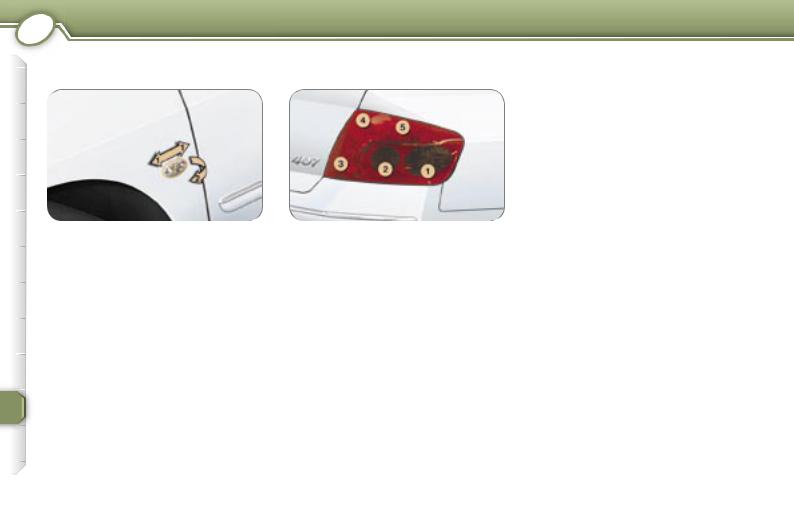
10 PRACTICAL INFORMATION
Integrated direction indicator side |
CHANGING A REAR BULB |
repeaters |
(SALOON) |
Push the repeater forwards or backwards and release it.
Unclip the repeater and change it.
Repeaters can be obtained from PEUGEOT dealers.
Amber coloured bulbs (direction indicators and side repeaters), must be replaced with bulbs of identical specification and colour.
1 - Direction indicators:
PY 21 W (amber).
2 - Reversing lights: P 21 W.
3 - Fog lamps/side lights:
P 21/4 W.
4 - Side lights: P 21/4 W.
5 - Brake lights/side lights:
P 21/4 W.
Disconnect the connector.
Unscrew the light fixing nuts inside the boot using the towing eye (stored inside the spare wheel), if necessary.
Remove the seal.
Unclip the bulb holder moving aside the 5 tabs.
Unscrew the bulb and change it.
Lock the bulb holder in place.
Reposition the seal.
Screw on the light fixing nuts inside the boot using the towing eye, if necessary. When refitting, ensure that the light is positioned and fixed correctly.
Reconnect the connector.
Number plate lights: W 5 W.
Remove the transparent cover using a screwdriver blade.
Change the faulty bulb.
Third brake light:
Five W 5 W bulbs.
Remove the plastic cover carefully by unclipping it at the centre and on either side, perpendicular to its direction of engagement.
Press on the two tabs located at the rear, near the rear screen.
Pull the red transparent cover outwards while maintaining the pressure on the tabs.
Change the faulty bulb.
When refitting, ensure that the tabs of the red transparent cover are engaged correctly and that the upper trim has been put back in place correctly.
118
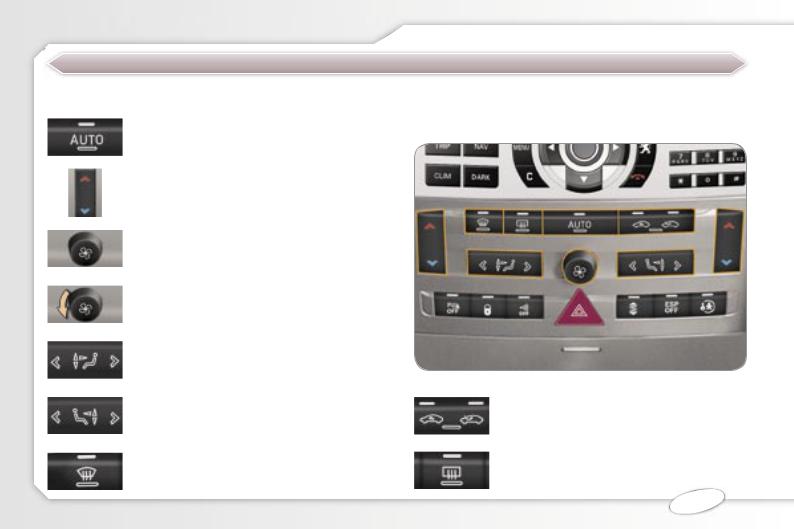
FAMILIARISATION
VENTILATION
Automatic air conditioning (dual zone)
Driver and passenger automatic programme (comfort).
Temperature adjustment, driver’s side.
Temperature adjustment, passenger side.
Air flow adjustment.
Air conditioning off.
Driver’s air distribution adjustment.
Passenger’s air distribution adjustment.
Front visibility control.
Intake of exterior air. Recirculation of interior air.
Rear screen demisting.
12 |
44 |
|

The electrical system of your vehicle is designed to operate with standard or optional equipment.
Before installing other electrical equipment or accessories on your vehicle, contact a PEUGEOT dealer.
PEUGEOT will not accept responsibility for the cost incurred in repairing your vehicle or for rectifying the malfunctions resulting from the installation of accessories not supplied and not recommended by PEUGEOT and not installed in accordance with its instructions, in particular where the equipment in question consumes more than 10 milliamperes.
The maxi-fuses provide additional protection for the electrical systems. All work must be carried out by a PEUGEOT dealer.
PRACTICAL INFORMATION 10
CHANGING A WINDSCREEN WIPER BLADE
Placing the wiper blades in the maintenance position
Less than one minute after switching off the ignition, press the windscreen wiper stalk down once to position the blades at the top of the windscreen (maintenance position).
Replacing a blade
Lift the arm, then unclip the blade and remove it.
Fit the new blade and fold down the arm.
To reposition the blades, switch on the ignition and operate the windscreen wiper stalk.
ECONOMY MODE FUNCTION
After the engine has stopped, certain functions (audio equipment, windscreen wiper, electric windows, sunroof, electric seats, telephone etc) are only supplied with power for approximately thirty minutes, to prevent complete discharging of the battery.
Once the thirty minutes are over, a message appears on the multi-function display and the active functions are put on standby.
These functions are automatically reactivated when the vehicle is started.
If the telephone is being used when economy mode starts, it will still be possible to finish the call.
A flat battery prevents the engine from starting.
As winter approaches, have your battery checked by a PEUGEOT dealer.
129
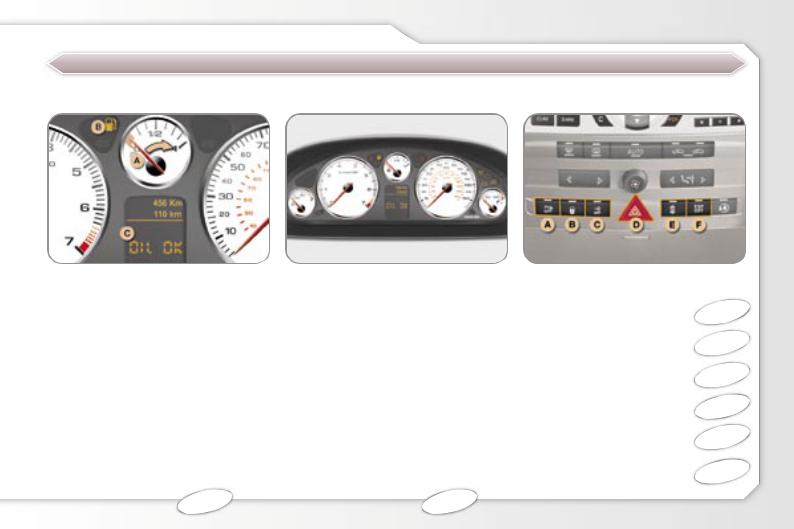
FAMILIARISATION
MONITORING
Instrument panel |
Warning lights |
Controls bar |
A.When the ignition is on, the fuel gauge needle should rise.
B.When the engine is running, its associated low level warning light should switch off.
C.When the ignition is on, the oil level indicator should display "OIL OK" for a few seconds.
If the levels are not correct, top up the level which is low.
16
When the ignition is on, the orange and red warning lights come on.
When the engine is running, these warning lights should switch off.
If a warning light remains on, refer to the page concerned.
20
Lighting of the indicator light indicates the status of the corresponding function.
A. Audible rear parking |
104 |
assistance off. |
B. Central locking.
C. Interior protection alarm |
70 |
off. |
D. Hazard warning lights.
E. Selection of the |
|
|
electronically controlled |
99 |
|
suspension. |
||
|
F. Electronic stability |
89 |
programme ESP off. |
13
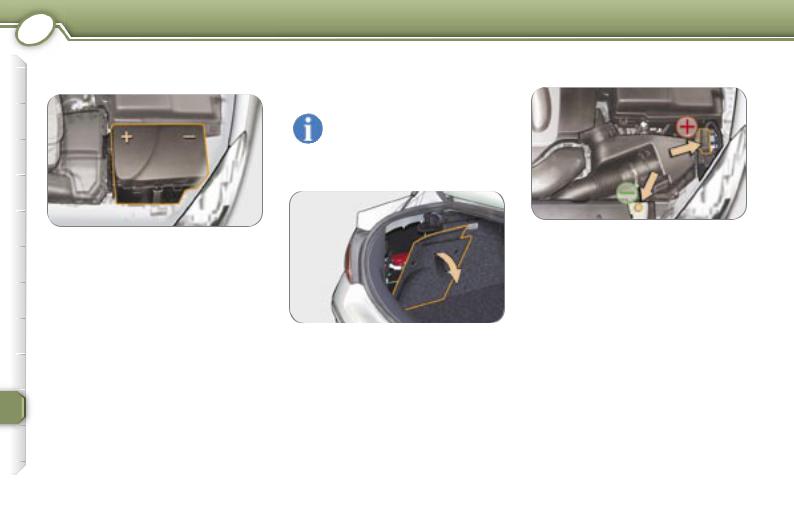
10 PRACTICAL INFORMATION
BATTERY (LOCATED IN THE ENGINE COMPARTMENT)
To charge the battery using a battery charger:
-Disconnect the battery,
-Follow the instructions for use given by the battery charger manufacturer,
-Reconnect starting with the negative (-) terminal,
- Check that the terminals and connectors are clean. If they are covered with sulphate (white or greenish deposit), disconnect them and clean them.
To start the vehicle from another battery:
- Connect the red cable to the positive
(+) terminals of the two batteries,
- Connect one end of the green or black cable to the negative (-) terminal of the slave battery,
- Connect the other end of the green or black cable to an earth point on the broken down vehicle as far as
130 possible from the battery,
-Operate the starter, let the engine run.
-Wait for the engine to return to idle, then disconnect the cables.
It is advisable to disconnect the battery if the vehicle is not to be used for a period of more than one month.
BATTERY (LOCATED IN THE BOOT)*
The battery is in the left boot trim.
To charge the battery using a battery charger (boot open):
fold down the panel to gain access to the battery,
disconnect the battery,
follow the instructions for use given by the battery charger manufacturer,
reconnect starting with the negative (-) terminal,
raise the panel and close it.
To start the vehicle from another battery:
open the bonnet,
use the two additional positive (+) and negative (-) terminals located under the bonnet,
open the red cover of the positive
(+)terminal,
connect the red cable between the positive (+) terminal and the positive
(+)terminal of the slave battery,
connect the green or black cable between the negative (-) terminal and the negative (-) terminal of the slave battery,
operate the starter, let the engine run,
wait for the engine to return to idle, then disconnect the cables,
close the red cover of the positive
(+)terminal,
refit the left side cover,
close the bonnet.
*Vehicles fitted with the 2.7 litre HDI 24V engine.
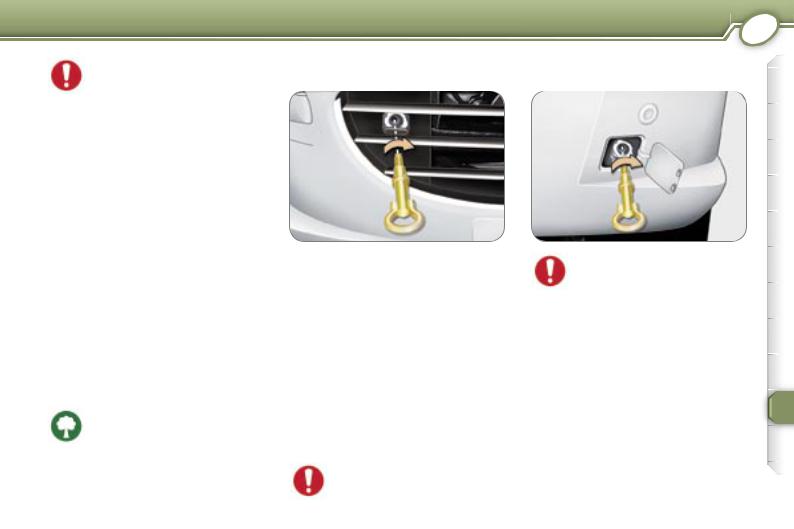
Before disconnecting the battery, you must wait for 2 minutes after switching off the ignition.
Never disconnect a terminal when the engine is running.
Never charge a battery without first disconnecting the terminals.
Open the windows and close the sunroof before disconnecting the battery. If they do not operate normally following reconnection of the battery, they must be reinitialised (see sections "Reinitialisation of the electric windows" and "Sunroof").
After every reconnection of the battery, switch on the ignition and wait 1 minute before starting to allow the electronic systems to be initialised. However, if slight difficulties are experienced after this, please contact a PEUGEOT dealer.
On the 2.7 litre 24V HDI engine, if there is no battery in the boot, do not connect a slave battery to the positive (+) and negative (-) terminals under the bonnet as a short circuit may occur.
The batteries contain harmful substances such as sulphuric acid and lead. They must be disposed of in accordance
with regulations and must never be discarded with household waste.
Take used batteries to an approved collection point.
|
PRACTICAL INFORMATION 10 |
TOWING YOUR VEHICLE |
Special features of the |
|
automatic gearbox |
Without lifting (4 wheels on the ground)
You must always use a towbar.
The removable towing eye is inside the spare wheel.
From the front:
Unclip the cover, by pressing the bottom part,
Screw in the towing eye as far as it will go.
From the rear:
Unclip the cover,
Screw in the towing eye as far as it will go.
When towing with the engine switchedoff,thereisnobraking or steering assistance.
Towing a vehicle with an automatic gearbox in reverse gear is prohibited (absence of lubrication).
When towing with four wheels on the ground, the following rules must be obeyed:
-lever in position N,
-tow the vehicle at less than 30 mph (50 km/h) over a maximum distance of 30 miles (50 km).
-do not add oil to the gearbox.
Lifting (2 wheels only on the ground)
It is preferable to raise the vehicle with a professional lifting device.
When towing with the engine switched off, there is no braking or steering
assistance. 131
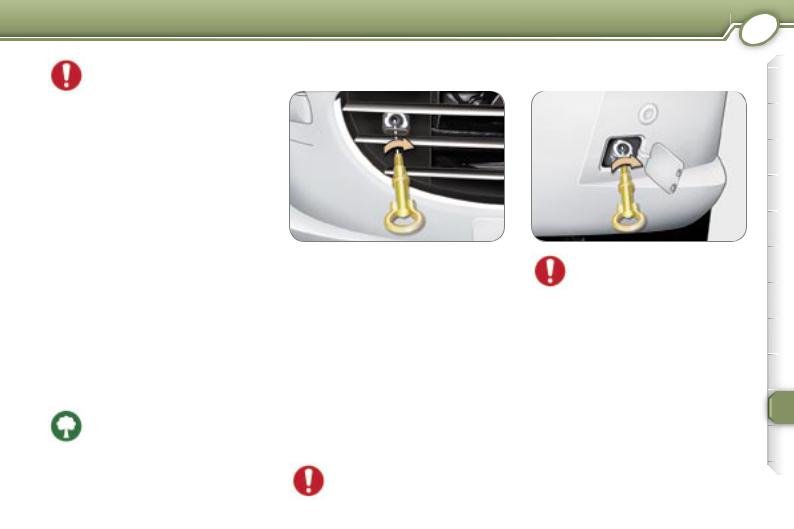
Before disconnecting the battery, you must wait for 2 minutes after switching off the ignition.
Never disconnect a terminal when the engine is running.
Never charge a battery without first disconnecting the terminals.
Open the windows and close the sunroof before disconnecting the battery. If they do not operate normally following reconnection of the battery, they must be reinitialised (see sections "Reinitialisation of the electric windows" and "Sunroof").
After every reconnection of the battery, switch on the ignition and wait 1 minute before starting to allow the electronic systems to be initialised. However, if slight difficulties are experienced after this, please contact a PEUGEOT dealer.
On the 2.7 litre 24V HDI engine, if there is no battery in the boot, do not connect a slave battery to the positive (+) and negative (-) terminals under the bonnet as a short circuit may occur.
The batteries contain harmful substances such as sulphuric acid and lead. They must be disposed of in accordance
with regulations and must never be discarded with household waste.
Take used batteries to an approved collection point.
|
PRACTICAL INFORMATION 10 |
TOWING YOUR VEHICLE |
Special features of the |
|
automatic gearbox |
Without lifting (4 wheels on the ground)
You must always use a towbar.
The removable towing eye is inside the spare wheel.
From the front:
Unclip the cover, by pressing the bottom part,
Screw in the towing eye as far as it will go.
From the rear:
Unclip the cover,
Screw in the towing eye as far as it will go.
When towing with the engine switchedoff,thereisnobraking or steering assistance.
Towing a vehicle with an automatic gearbox in reverse gear is prohibited (absence of lubrication).
When towing with four wheels on the ground, the following rules must be obeyed:
-lever in position N,
-tow the vehicle at less than 30 mph (50 km/h) over a maximum distance of 30 miles (50 km).
-do not add oil to the gearbox.
Lifting (2 wheels only on the ground)
It is preferable to raise the vehicle with a professional lifting device.
When towing with the engine switched off, there is no braking or steering
assistance. 131
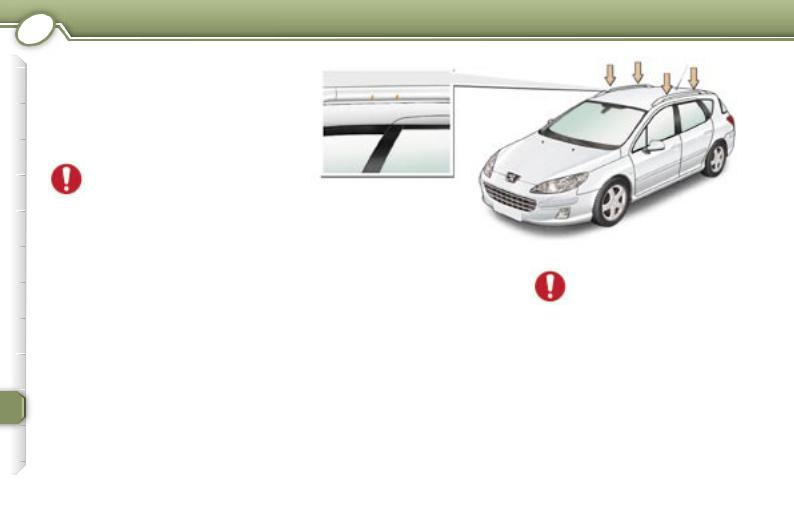
10 PRACTICAL INFORMATION
FITTING ROOF BARS (SALOON)
When fitting transverse roof bars, use the four quick-fit fixings provided for this purpose. Lift the concealing flaps and adjust the roof bar quick-fit fixings.
Maximum authorised weight on the roof rack, for a loading height not exceeding 40 cm (with the exception of bicycle carriers): 80 kg.
If the height exceeds 40 cm, adapt the speed of the vehicle to the profile of the road to avoid damaging the roof bars and the fixings on the roof.
Be sure to refer to national legisation in order to comply with the regulations for transporting objects which are longer than the vehicle.
FITTING ROOF BARS (407 SW)
When fitting transverse roof bars, ensure that they are positioned correctly.
The correct positions are shown by marks on each of the longitudinal bars.
Use accessories approved by PEUGEOT and follow the manufacturer’s fitting instructions.
Maximum authorised weight on the roof bars, for a loading height not exceeding 40 cm (except bicycle carriers): 100 kg.
If the height exceeds 40 cm, adapt the speed of the vehicle to the condition of the road, to avoid damaging the roof bars.
Please refer to national legislation to comply with the regulations regarding the transportation of objects which are longer than the vehicle.
132
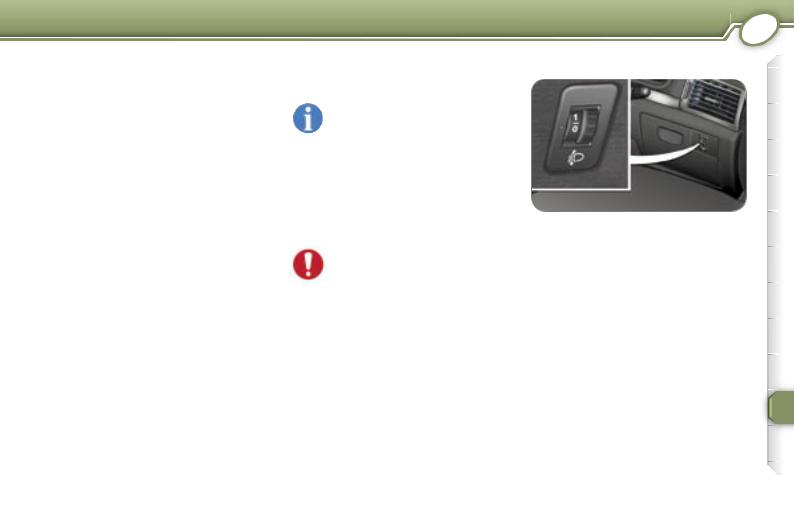
TOWING A TRAILER, CARAVAN, BOAT, ETC...
We recommend the use of original PEUGEOT towbars which have been tested and approved from the design stage of your vehicle and that you entrust the fitting of the towbar to a PEUGEOT dealer.
Driving advice
Distribution of loads: distribute the load in the trailer so that the heaviest loads are as close as possible to the axle and the nose weight is close to the maximum authorised without, however, exceeding it.
Cooling: towing a trailer on a slope increases the coolant temperature.
As the fan is electrically controlled, its cooling capacity is not dependent on the engine speed.
In the case of vehicles fitted with an HDI engine, it is advisable, following intensive use (towing on a motorway, prolonged driving,...), to leave the enginerunningatidleforapproximately 20 seconds before switching off the ignition. This limits any increase in the temperature of the engine after it has been switched off.
PRACTICAL INFORMATION 10
In all cases, pay attention to the coolant temperature.
Note: in certain cases of particularly arduous use (towing the maximum load in high temperatures on a steep
slope), the engine automatically limits its power and selects the appropriate automatic gearbox gear in manual mode. In this case, cutting off the air conditioning allows the engine power to be recovered, and therefore the towing capacity to be increased.
If the coolant temperature warning light comes on, stop the vehicle and switch off the engine as soon as possible.
Tyres: check the tyre pressures of the towing vehicle (label on the central door pillar on the driver’s side) and of the trailer towed, observing the recommended pressure.
Brakes: towing increases the braking distance. Drive at a moderate speed, change down early and brake gradually.
Side wind: sensitivity to side wind is increased. Drive smoothly and at a moderate speed.
Lighting
Manual adjustment
Adjust your headlamps so as not to dazzle other road users. Check the electrical signalling of the trailer.
133
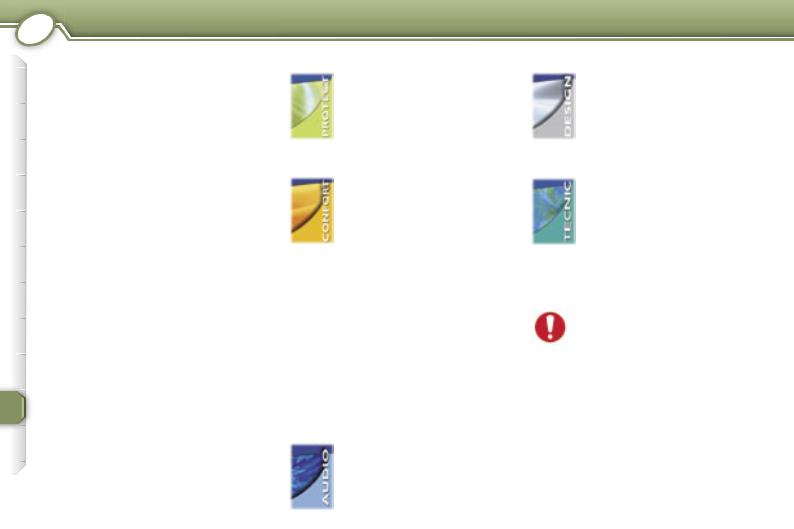
10 PRACTICAL INFORMATION
ACCESSORIES FOR YOUR 407
A wide range of accessories recommended by PEUGEOT and original parts are offered by the Network.
They all benefit from PEUGEOT’s recommendation.
These accessories and parts, having been tested and approved for reliability and safety, are all adapted to your PEUGEOT vehicle.
The product range offered by PEUGEOT Accessories is structured around 5 categories: PROTECTION - TOURING - IN-CAR TECHNOLOGY - STYLING - UNIVERSAL.
"Protection":
Anti-theft alarm, parking assistance, engraved windows, wheel anti-theft devices, first aid kit, warning triangle, high visibility safety jacket, snow chains, dog guard, etc.
"Touring":
Seat covers compatible with side air bags, mats, boot tray.
Forleisurepursuits:roofbars, transportation accessories (bicycle carrier, ski carrier), roof box, child seats and
booster cushions, rear screen blind, audio/telephone console, side blinds, cool box.
Trailer towbar which must be fitted by the PEUGEOT Network.
Note
To avoid any jamming under the pedals:
-ensure that the mat is positioned and secured correctly,
-never place one mat on top of another.
"In-Car Technology":
Telephone, hands-free kits, satellite navigation, CD changer, multimedia, connection for portable MP3 player (in the glove box).
"Styling":
Alloy wheels, wheel trims, spoiler, leather steering wheel, styling strips, door spoilers, stainless steel sill protectors.
"Universal":
Windscreen wash fluid, interior and exterior cleaning and maintenance products.
The fitting of electrical equipment or accessories which are not recommended by PEUGEOT may result in
a failure of your vehicle’s electronic system.
Please note this specific warning. You are advised to contact a representative of the Marque to be shown the range of recommended equipment and accessories.
134
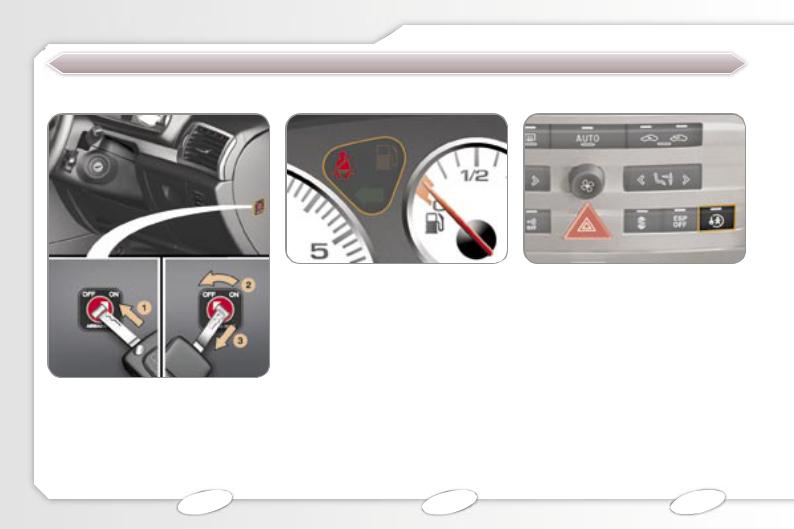
FAMILIARISATION
KEEPING YOUR PASSENGERS SAFE |
|
|
Front passenger air bag |
Detection of fastening of the |
Electric child lock |
|
front seat belts |
|
1.Insertion of the key.
2.Selection of the "OFF" position.
3.Removal of the key keeping the switch in this position.
When the ignition is switched on, if a front occupant has not fastened his seat belt and if the vehicle speed is below 12 mph (20 km/h), you are warned by lighting of the seat belt warning light.
The warning light switches off when the seat belt(s) concerned is(are) fastened.
If the vehicle speed is above 12 mph (20 km/h), you are warned by flashing of the seat belt warning light, an audible signal and a message on the multifunction display locating the unfastened seat belt(s).
This prevents opening of the two rear doors from the inside.
With the ignition on, press the button.
A message appears on the multifunction display.
You are advised to check the activation of the child lock each time the ignition is switched on.
14 |
94 |
91 |
69 |
|
|
|
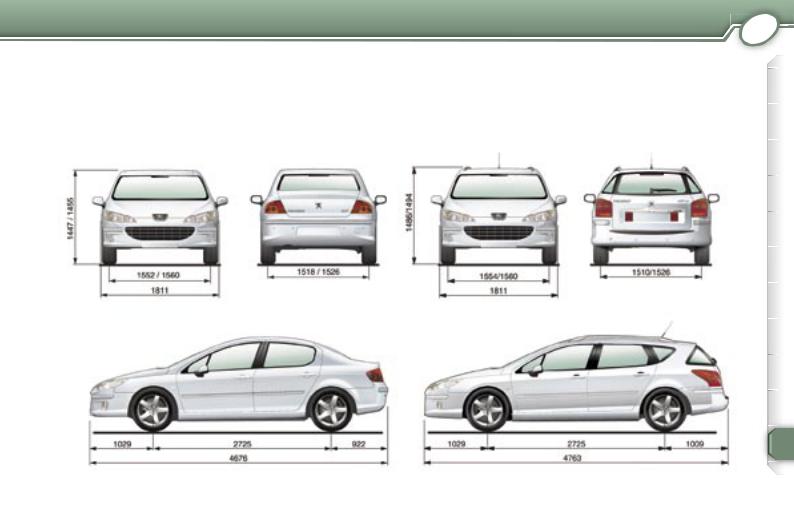
|
TECHNICAL DATA 11 |
DIMENSIONS (in mm) |
|
407 saloon |
407 SW |
145

11 TECHNICAL DATA
IDENTIFICATION FEATURES OF YOUR 407
A - Manufacturer’s plate.
B - Serial number on the bodywork.
C - Serial number on the fascia (visible at the bottom of the windscreen).
D - Tyre pressure and paint colour reference label.
The label D on the pillar near to the door hinges on the driver’s side indicates:
-the wheel and tyre sizes,
-the brands of tyres approved by the manufacturer,
-the tyre pressures (the pressure must be checked cold, at least once a month),
-the paint colour reference.
E - Front number plate.
In the event of replacement, a front number plate of a height less than or equal to 110 mm must be fitted provided that this
size conforms to current regulations.
Otherwise, contact a PEUGEOT dealer.
146
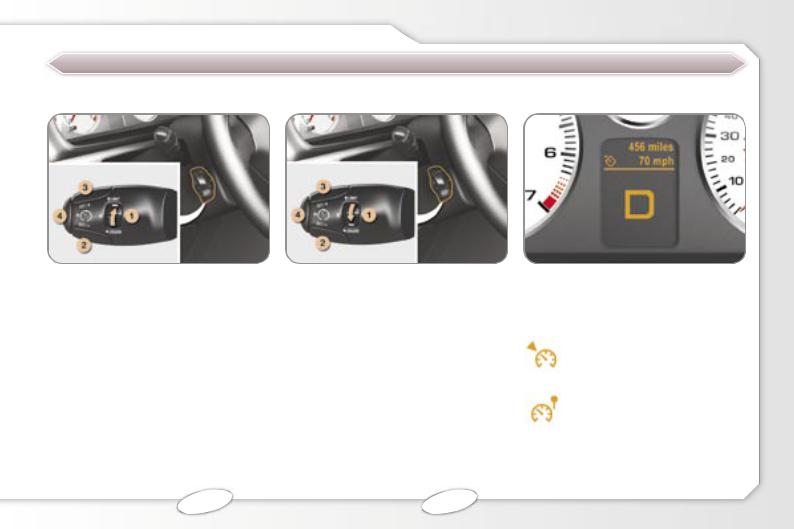
FAMILIARISATION
DRIVING SAFELY
Cruise control |
Speed limiter |
Instrument panel display |
1.Cruise control mode Selection / Off.
2.Decrease of the programmed value.
3.Increase of the programmed value.
4.Cruise control On / Off.
In order to be programmed or activated, the vehicle speed must be above 25 mph (40 km/h), with at least fourth gear engaged on the manual gearbox.
1.Speed limiter mode Selection / Off.
2.Decrease of the programmed value.
3.Increase of the programmed value.
4.Speed limiter On / Off.
The values must be set with the engine running.
The cruise control or speed limiter mode appears on the instrument panel when it is selected.
Cruise control
Speed limiter
100 |
102 |
15 |
|
|
